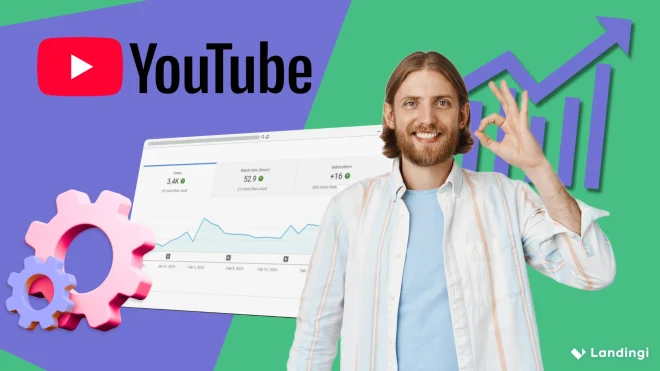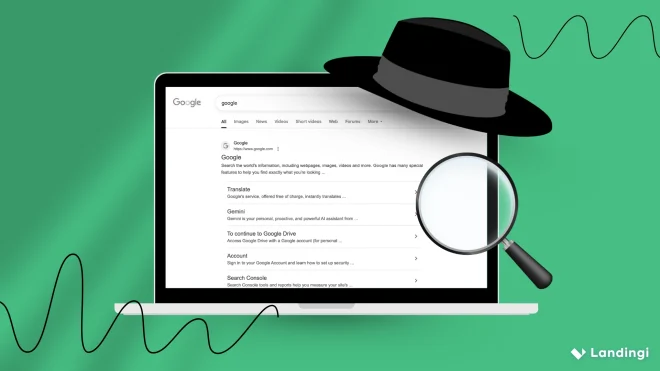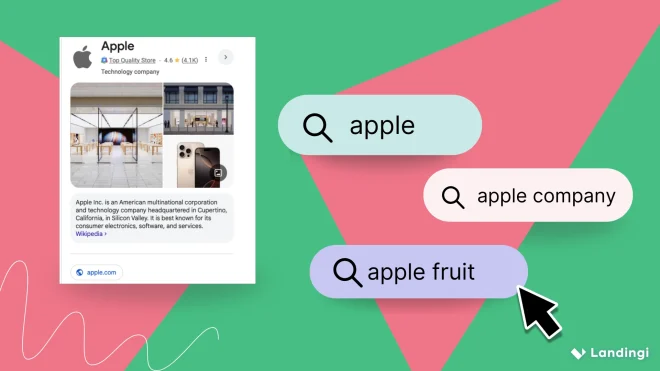YouTube SEO is the key to unlocking massive organic reach on the world’s second-largest search engine – yes, it’s YouTube. The whole process involves optimizing videos, metadata, and channel structure to improve video SEO ranking and appear higher in search results and recommendations. But why does this matter?
According to Search Engine Journal, channels with top videos had an average engagement rate of 4.46% – this engagement rate indicates that channels within that top tier aren’t just getting views; they’re actively fostering interaction. Therefore, successful YouTube SEO isn’t merely about stuffing keywords; it’s about crafting content that genuinely resonates with viewers and encourages them to engage, which turns into enhanced brand awareness, higher organic traffic, and, ultimately, a strong return on investment for your content strategy and business objectives.
Are you curious about how to develop an effective YouTube SEO strategy? This article explains YouTube SEO, shares a practical YouTube SEO checklist, and breaks down the exact steps you need to rank videos and maximize results. Read on and transform your YouTube channel into a powerful growth engine.

What Is YouTube SEO?
YouTube SEO is a specialized subset of SEO that optimizes videos, playlists, and channel pages to rank higher in YouTube search results and recommendations. The aim is to make your content more discoverable for users and make it easier for YouTube’s algorithm to analyze and promote your videos.
Compared to traditional SEO, YouTube SEO focuses on platform-specific ranking factors and pays attention especially to user engagement metrics. Therefore, YouTube SEO works by optimizing video thumbnails, using closed captions, improving metadata, and encouraging user interactions to boost visibility. With a proper YouTube strategy, focused on signaling to the algorithm the relevance, quality, and engagement potential of your content, you can boost views, enhance engagement, and foster channel growth.
Rank your videos, then capture leads! Build high-converting pages and use videos to drive traffic.
Why Is YouTube SEO Important?
YouTube SEO is important because it significantly boosts your video’s visibility and organic reach, not just on YouTube but also on Google search results. As the second-largest search engine in the world, YouTube processes over 3 billion searches each month, presenting a golden opportunity to connect with a vast, global audience. However, even high-quality videos may remain undiscovered without SEO, limiting potential growth, subscribers, and conversions.
While every YouTube SEO strategy focuses mainly on boosting engagement, it provides more benefits than just increased watch time and subscriber counts. It also drives significant brand authority, diversified organic traffic, and long-term growth for your business. Additionally, it positions your content to appear in Google’s universal search results, expanding your reach beyond YouTube’s platform and capturing users at various stages of their search journey. This means that creating videos and leveraging YouTube SEO to boost their rankings helps attract new potential customers and drive business growth.
How to Rank Videos on YouTube with SEO?
To rank videos on YouTube with SEO, focus on the 3 main optimization areas: metadata, engagement signals, and content quality – but remember that the foundation is the proper keyword research. Once you’ve identified relevant keywords (detailed instructions are provided below), it’s crucial to optimize your video metadata. Start by crafting a clear and engaging title that features your main keyword, ideally placing it at the beginning. To avoid keyword stuffing and enhance search relevance, ensure your titles are at least five words long.
Then, pay attention to the video description – mention your target keyword at least two times naturally so that not only YouTube but also Google can understand your video’s context. Add relevant – broad and specific – tags to maximize discoverability, and choose a few hashtags to increase your video’s visibility in suggested videos and YouTube’s search.
As audience retention is a major ranking factor, your content must be valuable and engaging for viewers and keep them watching it as long as possible. Engagement matters most on YouTube – the more likes, comments, shares, and subscriptions you get, the higher your videos rank. Therefore, increase engagement by encouraging actions – strong CTAs at the start and end of videos help drive these interactions.
Lastly, the YouTube algorithm also rewards technical and accessibility optimization. Add accurate captions and transcripts – YouTube’s algorithm can crawl these, which not only improves its understanding of your content but also enhances the user experience for a wider audience. Design eye-catching thumbnails that accurately represent your content, as custom thumbnail images directly impact click-through rates and thus influence rankings. Finally, use chapters to organize content, and add cards and end screens to promote related videos and increase session time.
6 Proven YouTube SEO Tips and Best Practices
To go beyond the basics, an effective YouTube SEO strategy involves a thorough understanding of the platform’s nuances and the implementation of best practices, including:
- crafting a robust content plan,
- organizing videos into playlists,
- utilizing timestamps,
- incorporating interactive elements in your videos,
- promoting videos across social media platforms,
- and leveraging analytics to optimize your videos.
Explore these 6 six proven YouTube SEO tips and learn how to boost video visibility, enhance viewer engagement, and fortify the overall authority of your channel.
1. Build a Cohesive Content Strategy
The first best practice is to develop a strong content strategy – it’s the foundation of effective YouTube SEO because it ensures all published material aligns with clear goals and audience expectations. Consistent planning helps balance different content formats, such as YouTube Shorts for quick engagement and longer videos for in-depth exploration, maximizing reach across varied audience preferences.
How to do it:
To develop an effective strategy, begin by pinpointing your target audience and the main topics of interest. Next, create a publishing calendar that incorporates both evergreen and trending themes. A good practice is to leverage video marketing techniques, such as storytelling and strong branding, to keep your audience captivated and coming back for more.
You can manage scheduling directly within YouTube or through dedicated social media schedulers such as SocialBee, which allow you to efficiently plan, queue, and cross-promote when you produce videos regularly. A well-executed strategy with consistently published content ultimately strengthens your channel’s authority and improves performance in YouTube’s algorithm.
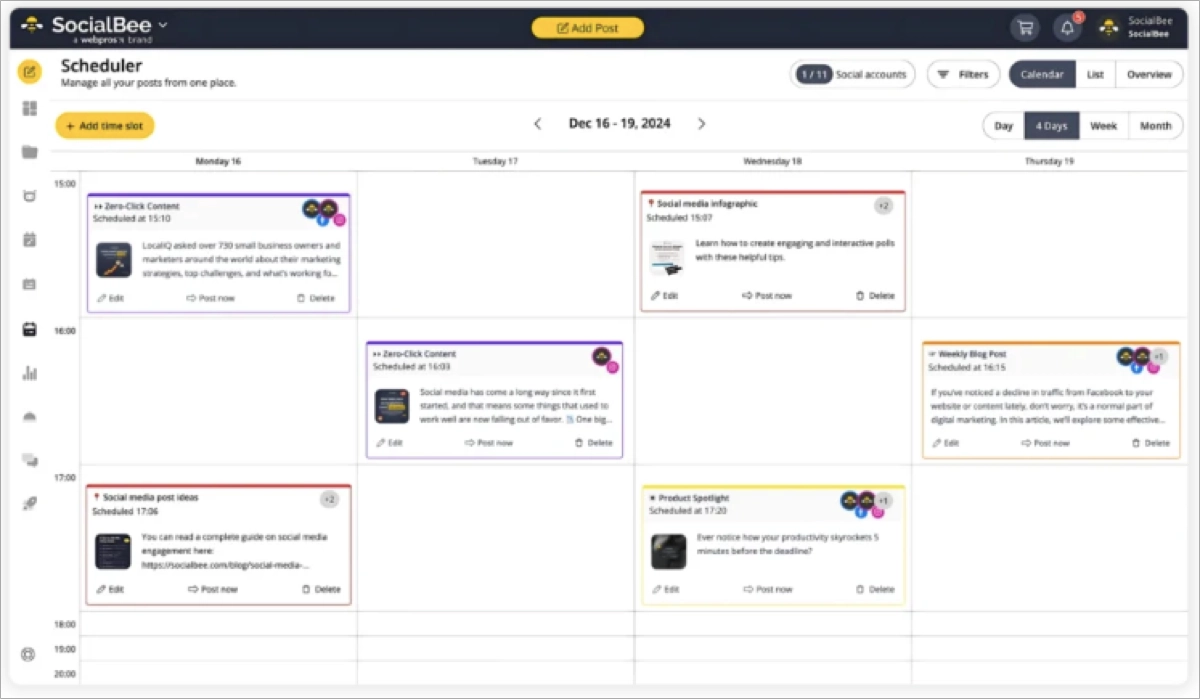
2. Group Videos into Relevant Categories and Playlists
The second best practice involves organizing your videos into clearly defined categories and playlists. This not only boosts your YouTube SEO but also makes it easier for viewers to discover your content and enhances the duration of their watch sessions. When users come across a collection of related videos, they’re more likely to keep watching, which signals to the algorithm that your channel has both: depth and relevance.
How to do it:
Review your existing videos and identify logical groupings based on topic, format, or audience interest. Create playlists with clear, keyword–rich titles that reflect these themes. Playlists not only help viewers navigate related content but also enhance internal linking throughout your channel, thereby strengthening your authority on specific topics. By carefully organizing your content, you increase the likelihood that both new and returning viewers will stay engaged longer, ultimately boosting your channel’s rankings.
Take a look at the example below – the content is grouped into playlists based on topics. It’s the best way to encourage viewers to watch more of your videos.
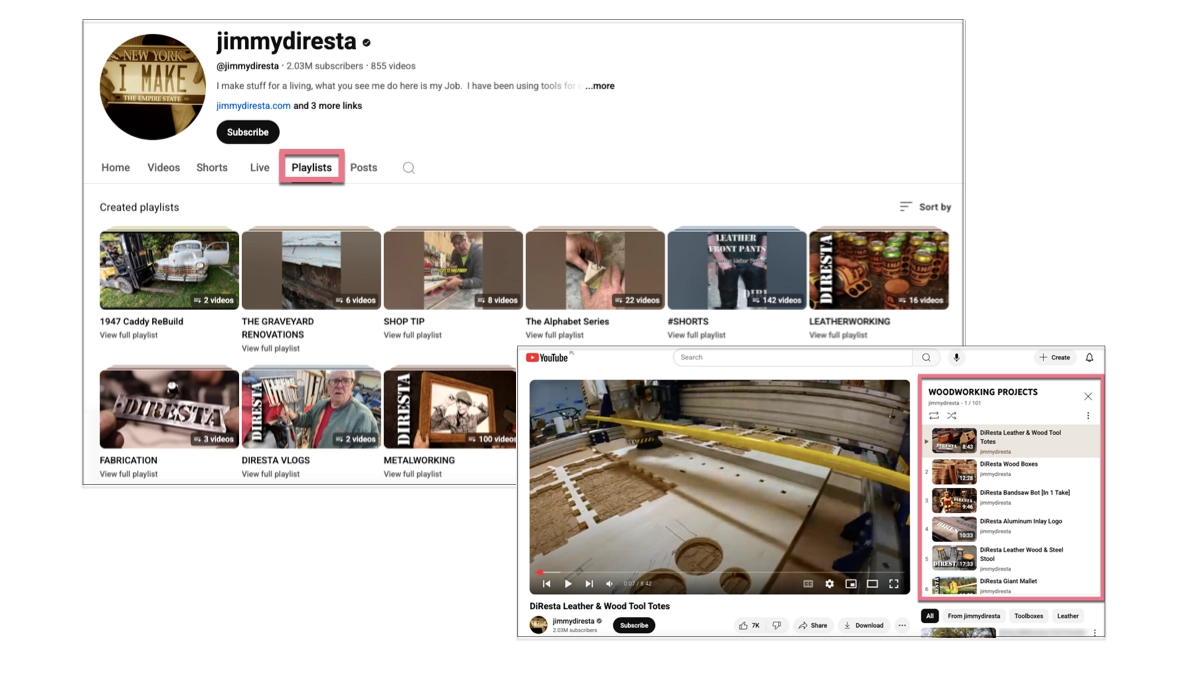
3. Use Timestamps
Another essential tip to boost your YouTube SEO is to use timestamps. They help both viewers and the algorithm grasp the structure of your video and pinpoint its key sections. This is especially significant for longer content, as precise timestamps greatly improve the viewer experience. Audiences will appreciate being able to jump straight to the parts that matter most to them, no matter how lengthy the video is.
How to do it:
To apply timestamps effectively, pinpoint the main sections or topics discussed in the video and note their precise time markers. Include these in the video description using the 00:00 format, and make sure each label is clear and relevant to the keywords. This approach not only enhances viewer satisfaction and retention but also increases your chances of showing up in Google’s featured snippets and YouTube search results, as the algorithm can more effectively index the segmented content.
Look at how others use timestamps in their video descriptions. This feature lets viewers jump to the parts of longer videos they care about most. Timestamps also help YouTube’s algorithm understand the topics covered in the video, which makes it easier for people to find it during relevant searches.
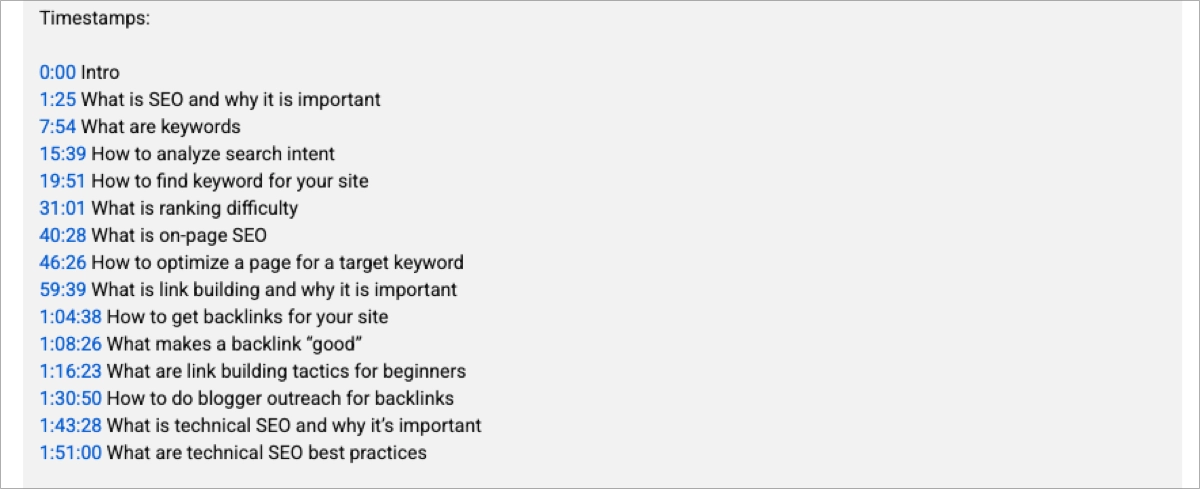
4. Add Interactive Video Elements
The fourth tip is to add interactive video elements to improve engagement, which is a key factor when optimizing YouTube videos for better rankings. This matters because elements like end screens, info cards, and polls encourage viewers to take actions, such as watching another video, subscribing, or participating in a survey. It increases session time and interaction signals valued by the YouTube algorithm.
How to do it:
To implement interactive video elements, use YouTube Studio to insert relevant end screens promoting related content or playlists, and add info cards that link to helpful resources or other parts of your channel. Ensure that these elements harmonize with the video’s message, making them appear seamless and engaging. Incorporating interactive features not only adds dynamism to your videos but also reinforces the internal linking structure, enhancing the overall SEO effectiveness.
Take a look at the example below – this end screen includes related videos, encouraging YouTube users to discover more content, and the link to the creator’s YouTube profile, encouraging viewers to subscribe to the channel page.
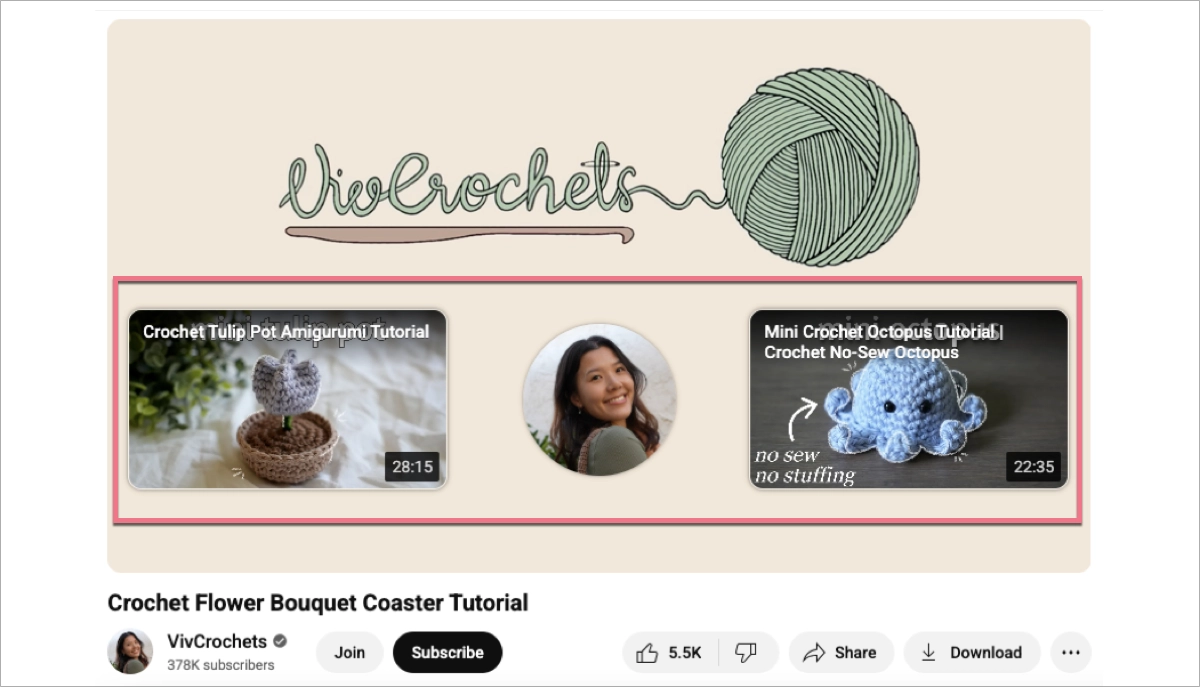
5. Distribute Your Content
The fifth best practice is to promote your videos across external channels. This is an essential part of video marketing, as it significantly amplifies your YouTube SEO efforts by driving additional traffic and increasing engagement. Promoting videos beyond YouTube helps attract new viewers, create backlinks, and generate social signals, all of which strengthen video authority and ranking potential.
Embed your YouTube videos on landing pages and turn views into conversions with Landingi today!
How to do it:
To distribute your content effectively, share each new upload across your social media platforms, embed videos in blog posts, include them in newsletters, or collaborate with industry influencers. The key step is to tailor your messaging for each platform to match audience expectations and maximize click-throughs. Consistent external distribution expands your reach, boosts initial view velocity, and sends strong relevance signals back to YouTube’s algorithm, enhancing overall discoverability.
Check out how it can be done on Facebook – the post’s copy builds engagement, answers the audience’s interests, and encourages them to learn more by watching the video on YouTube. The thumbnail image is important here, as Facebook users are likelier to click on visually appealing posts.
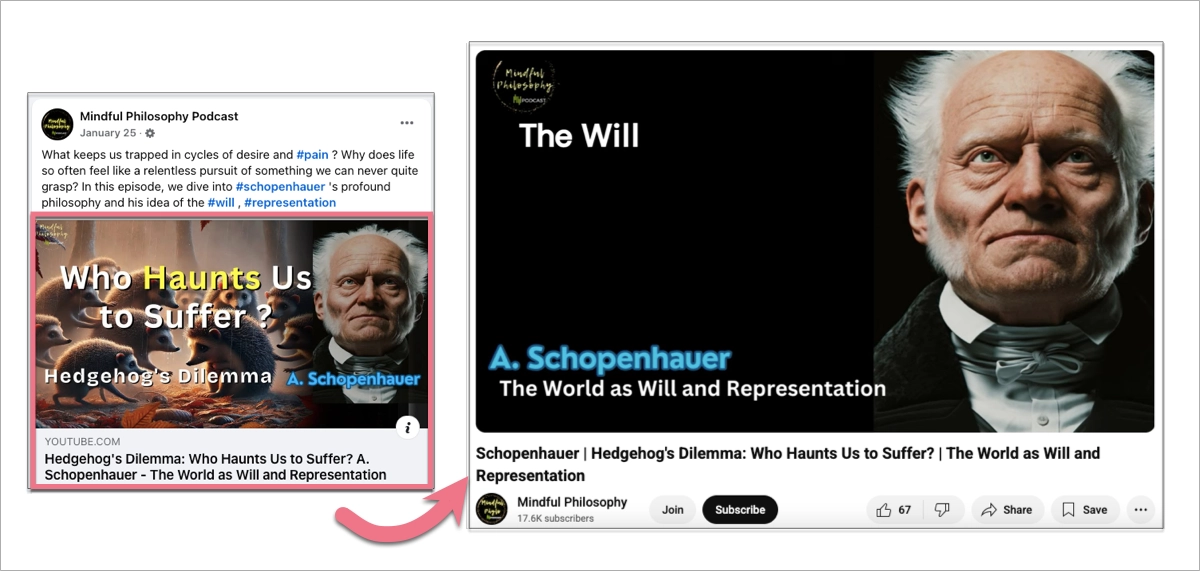
6. Analyze Performance to Improve Strategies
The last but most important best practice for YouTube SEO success is to analyze your channel’s and videos’ performance to refine your strategies. Detailed performance data helps you understand how multiple videos perform across metrics like watch time, click–through rate, and audience retention, directly influencing YouTube’s search algorithm rankings. Thanks to a comprehensive analysis, you can find which elements need improvement and adjust your strategy to maximize your organic reach, engagement, and ultimately, your overall channel growth.
How to do it:
Leverage YouTube Analytics in YouTube Studio to monitor key metrics and uncover trends. Pair this data with specialized tools like TubeBuddy for more in-depth insights and competitor comparisons. By regularly reviewing this information, you can identify patterns, tweak underperforming content, and capitalize on successful formats, which helps ensure ongoing improvement and stronger growth for your channel in the long run.
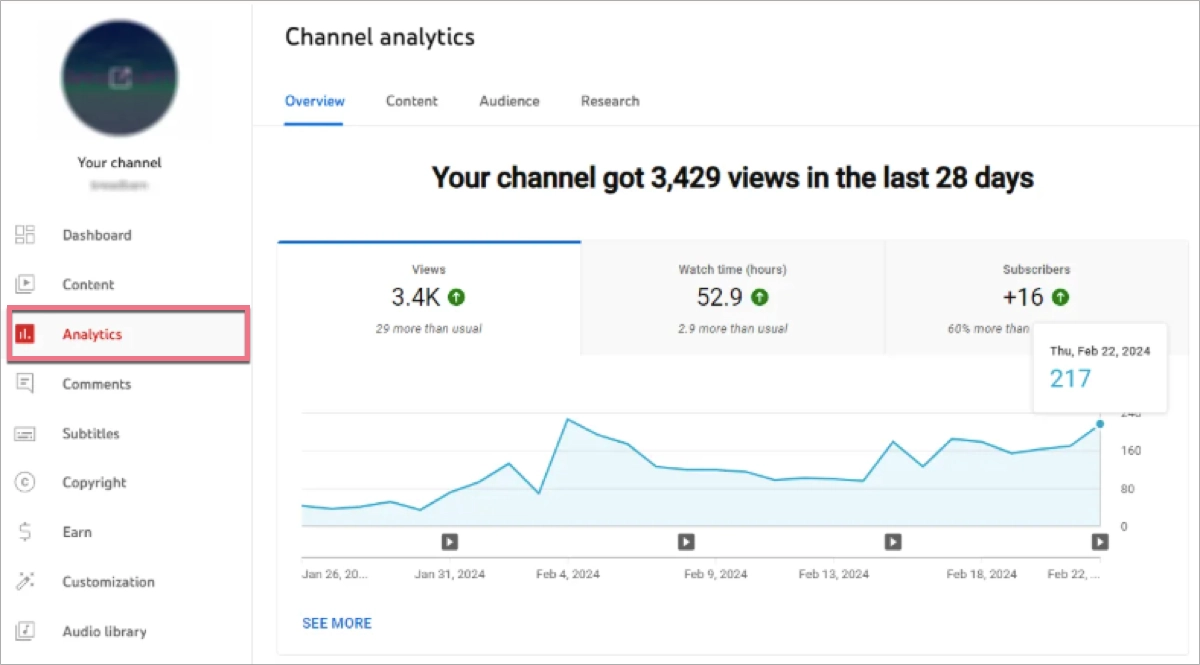
How to Perform YouTube SEO Keyword Research?
To perform YouTube keyword research, you need to identify the exact phrases people search for, either through YouTube itself or by using dedicated tools. Knowing what keywords match your topic, you can align your content with user intent and strengthen your YouTube SEO strategy.
There are two main ways to do this. First, type your main topic into the YouTube search bar and review the autocomplete suggestions. These reflect popular and trending searches directly from users. It’s a simple but effective method – perfect for beginners –that gives you quick insights into relevant target keyword ideas.
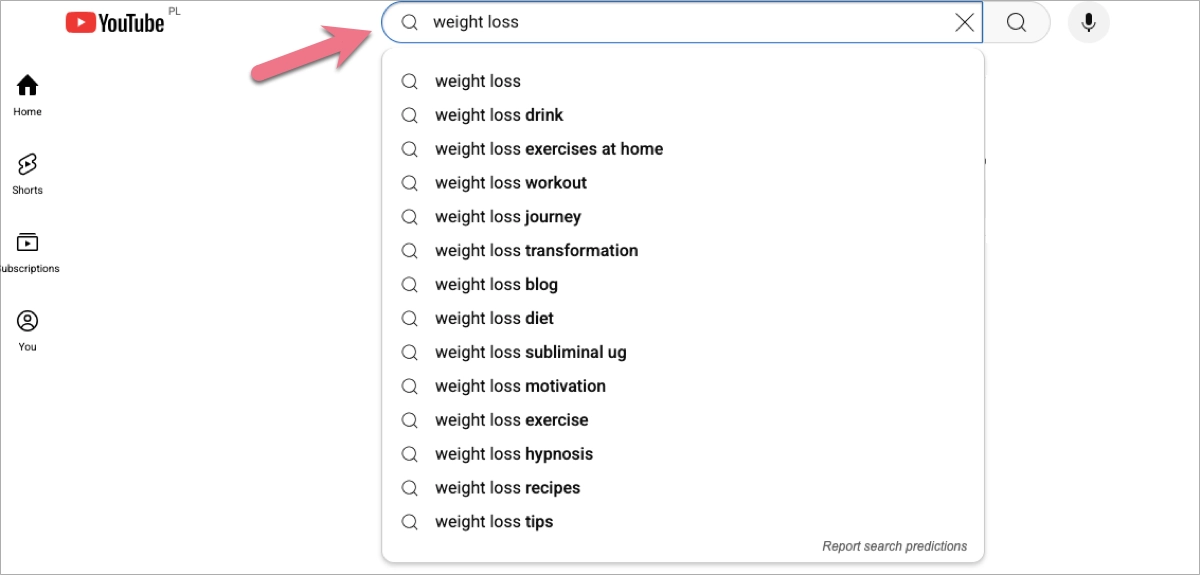
For more in-depth research, consider using tools such as Ahrefs Keyword Explorer. This platform offers an extensive list of related keywords, along with essential metrics like search volume and difficulty, making it easier to refine your strategy.
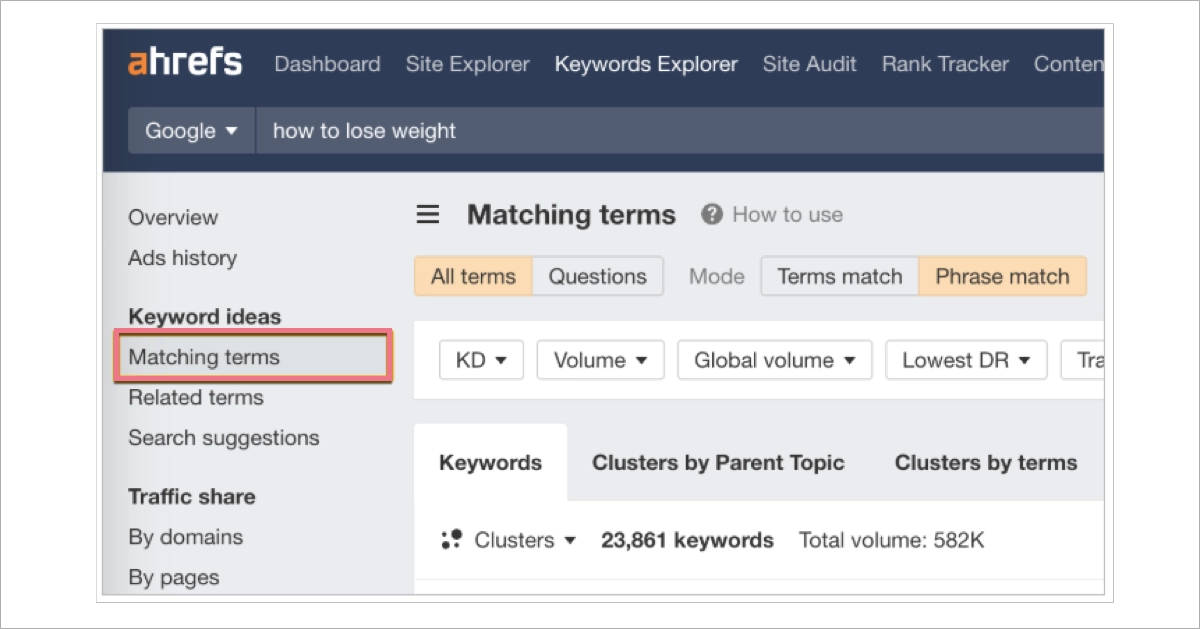
You can further filter these keywords specifically for videos, helping you identify the most valuable opportunities for ranking. This approach enables you to pinpoint the most promising opportunities for improving your rankings. By examining factors such as search volume or competition level, you can identify which keywords are not only relevant but also highly effective in attracting target audiences.

This strategic focus allows you to optimize your video titles, descriptions, and tags, ultimately increasing visibility and boosting your chances of success on YouTube.
What Is the Best YouTube SEO Checker?
The best YouTube SEO checker is Morningfame, a YouTube-focused analytics and optimization tool. It provides user-friendly reports that detail video and YouTube channel performance, offer keyword suggestions, and deliver in-depth SEO scores for titles, descriptions, tags, and thumbnails.
Morningfame streamlines the process of tracking how well your content meets YouTube’s search engine optimization standards while highlighting areas that need improvement. Its keyword research tools help sharpen your YouTube SEO strategy, making it perfect for creators looking to improve their rankings and grow their audience.
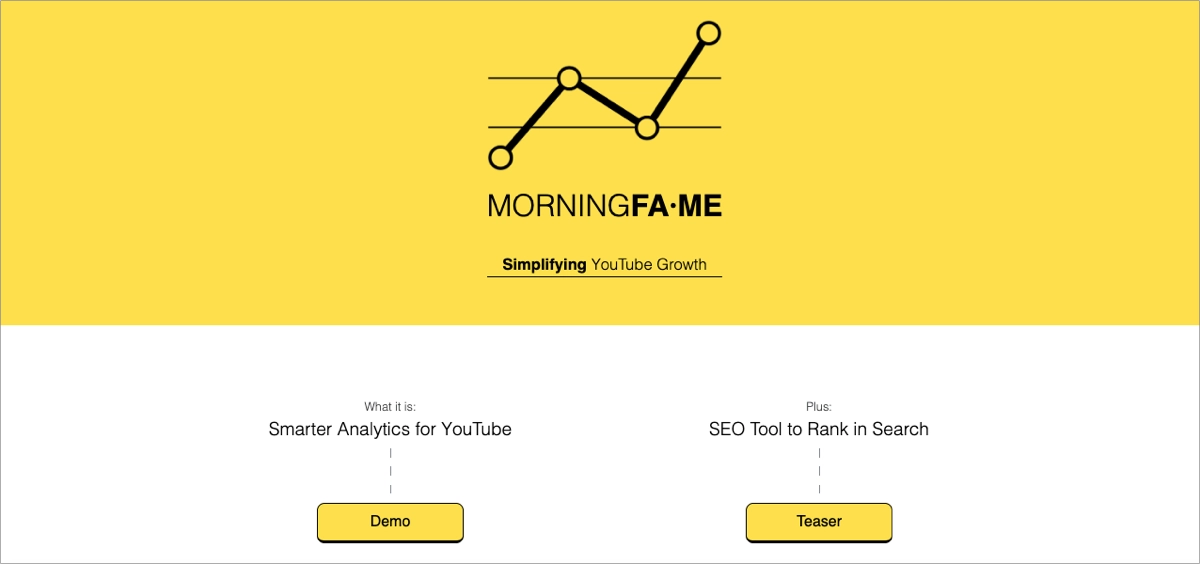
However, to access this tool, you need a special invitation code – the good news is that they provide instructions on how to get it! The first month is free, and then you can choose between a few affordable paid plans.
What Are the Best YouTube SEO Courses?
There are many YouTube SEO courses promoted across the web, but few of them are genuinely worth your attention, like the YouTube SEO SECRETS Course on Udemy, or YouTube Marketing and YouTube SEO Fundamentals on the Alison platform. If you’re just starting out or have some experience under your belt, YouTube SEO SECRETS is an excellent choice for you. This course is a step-by-step, actionable guide to help you rank your videos and grow your channel effectively.
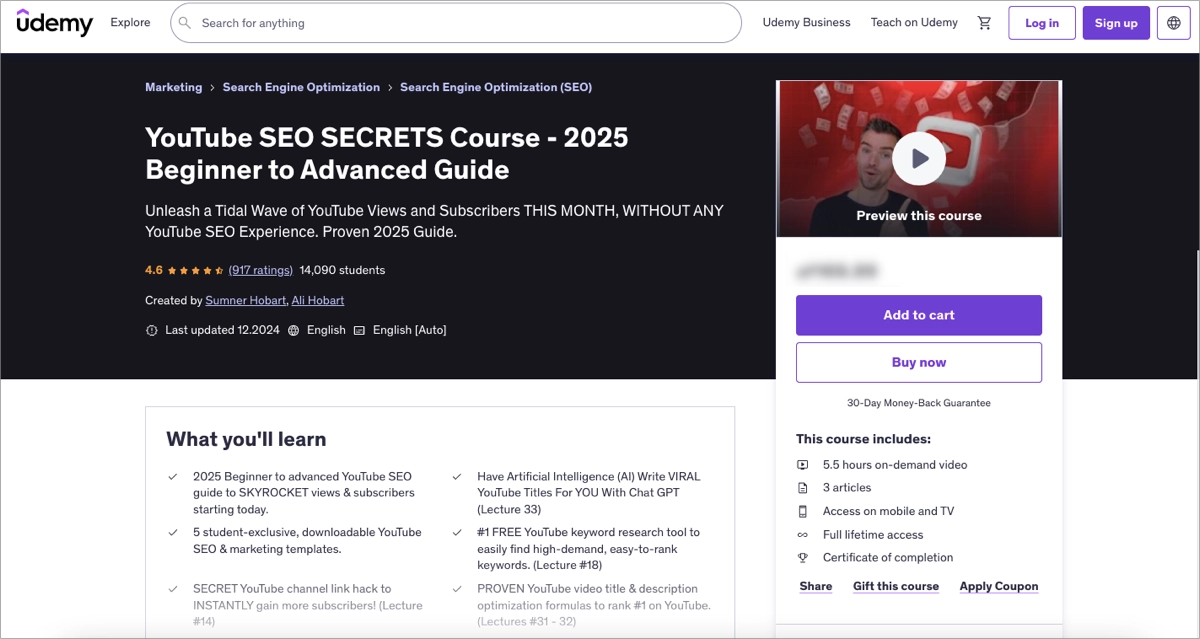
It dives into crucial topics such as thorough YouTube SEO strategies, crafting AI-driven titles, conducting keyword research, optimizing your videos, and enhancing audience retention. Additionally, it offers downloadable templates and access to free keyword tools to support your journey.
The YouTube Marketing and YouTube SEO Fundamentals by Jon Russel is another great beginner-level course that teaches the basics of YouTube SEO, search engine ranking position (SERP), and effective YouTube video marketing. You’ll learn how to optimize your videos for search, create engaging content, and market your channel for growth.
Both courses offer certifications, so they provide a tangible credential that can validate your knowledge to potential employers or clients, demonstrating a commitment to continuous learning and a foundational understanding of key YouTube optimization strategies.
What Are the Best YouTube SEO Tools?
The best YouTube SEO tools are TubeBuddy, VidIQ, and YouTube Studio, each offering unique features to improve video optimization, track performance, and strengthen your SEO strategy. Check out what makes these tools effective – consider their features and pricing, and find out how these solutions can elevate your YouTube channel’s visibility and help you achieve significant organic growth.
TubeBuddy
TubeBuddy is a browser extension that provides in-depth insights into tags, target keywords, titles, and descriptions, ensuring that your content aligns with YouTube’s search engine optimization (SEO) standards. Additionally, it offers tools for competitor analysis, thumbnail testing, and performance tracking, making it a comprehensive resource for enhancing your rankings. It also provides bulk editing tools, allowing editing of end screens, cards, and descriptions across multiple videos at once.
In a few words, TubeBuddy is user-friendly, offers a robust free plan, and provides actionable insights for channels of any size – it’s a perfect tool for every creator looking to streamline their workflow and significantly boost their YouTube SEO performance.

VidIQ
Another fantastic tool for YouTube SEO is VidIQ, which provides real-time video analytics, keyword tools, and a comprehensive SEO scoring system. This helps users pinpoint high-performing topics and keep an eye on their competitors. With features like a video scorecard, keyword research, and trend alerts, VidIQ equips creators with valuable insights to optimize their content and boost their visibility on YouTube’s platform.
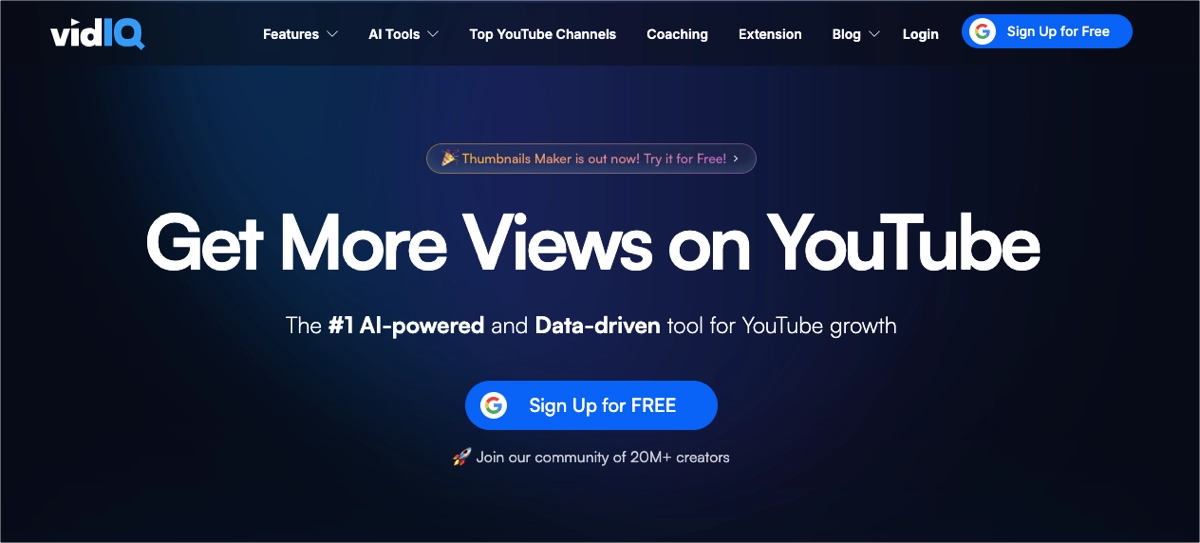
YouTube Studio
YouTube Studio is a built-in dashboard for managing and optimizing your channel. It offers analytics like watch time, audience retention, and traffic sources, helping creators understand what works and adjust SEO strategies directly within the YouTube ecosystem. Beyond that, it also offers search insights and content gap analysis, allowing you to identify trending topics your audience is searching for and uncover opportunities to create new, in-demand content that can fill existing gaps in your niche.
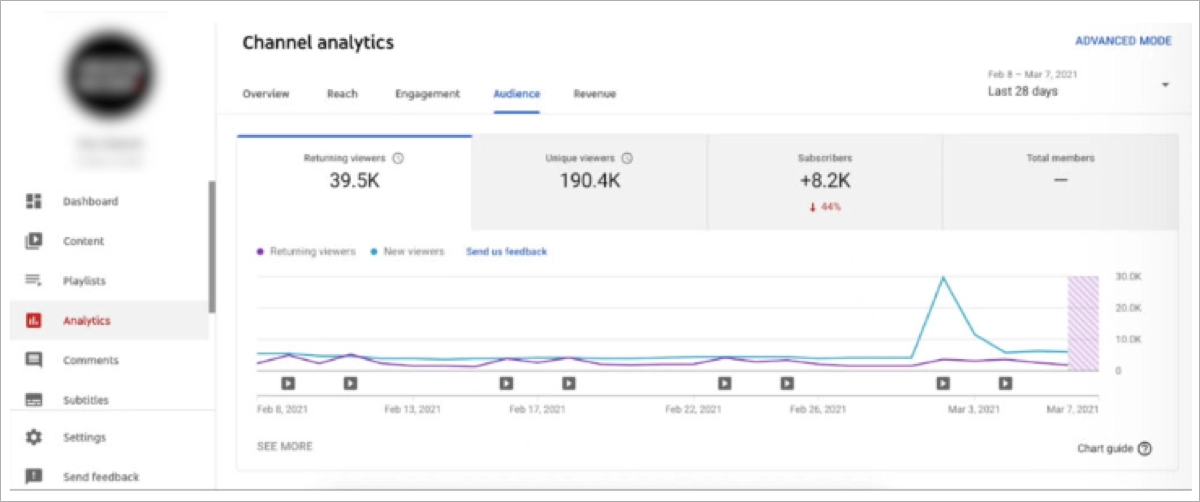
For the best YouTube SEO results, combine the advanced optimization features of TubeBuddy and VidIQ with the in-depth analytics and management tools of YouTube Studio. This trio gives you everything you need to research, optimize, and track your channel’s growth effectively – check this out in the comparison table below:
| Main Focus | Key SEO Features | Unique Strength | |
|---|---|---|---|
| TubeBuddy | Advanced optimization and bulk management | Keyword suggestions, tag rankings, SEO scores, A/B thumbnail testing | Bulk tools for large channels, competitor tracking, extension-based |
| VidIQ | Keyword research and competitive insights | Real-time analytics, keyword scorecard, trend alerts, tag suggestions | Strong competitive analysis, trending topic discovery |
| YouTube Studio | Official channel management and analytics | Watch time, retention, traffic source tracking, metadata adjustments | Direct YouTube integration, no extra tools required |
Where to Find the Best YouTube SEO Checklist?
You can find YouTube SEO checklists on industry blogs, marketing agencies‘ websites, and within specific platforms‘ resources. For instance, ClickMinded provides a downloadable YouTube SEO Checklist witha step-by-step guide to optimizing your videos and channel for maximum organic reach, and JAS AGENCY shares a YouTube SEO checklist as a blog post.
Ultimately, the best YouTube SEO checklist for you will depend on your specific needs and current knowledge level. Whether you prefer a comprehensive downloadable guide or a detailed blog post, utilizing a well-structured checklist ensures you cover all the essential aspects of YouTube optimization and effectively boost your channel’s performance.
What Are the Key YouTube SEO Ranking Factors?
The main areas that YouTube uses to rank videos include relevance, engagement, and watch metrics, but the specific YouTube SEO ranking factors involve:
- Keyword Optimization
- Video Metadata
- Watch Time
- Audience Retention
- Engagement Metrics
- Click-Through Rate
- Upload Frequency
- Video File Name
- Playlists and Session Duration
- Technical and Accessibility Factors
Relevance is largely determined by keyword optimization and video metadata, ensuring titles, descriptions, and tags accurately reflect the content and align with what users are searching for. The video file name also plays a small role in initial categorization. Beyond this basic relevance, the algorithm heavily weighs how users interact with your content. This includes watch time (total minutes watched), audience retention (the percentage of the video viewers who watch), and engagement metrics such as likes, comments, and shares, which signal to YouTube that the content is valuable.
A high click-through rate on your thumbnails and titles further indicates compelling content. Consistent upload frequency and well-organized playlists contribute to overall channel health and encourage longer session durations on the platform. Finally, technical and accessibility factors, like captions and video quality, improve discoverability and user experience for a wider audience. Mastering these interconnected elements is crucial for boosting your content’s visibility and thriving on the platform.
Want more from your videos? Embed them on landing pages and watch conversions grow!
Use YouTube SEO to Improve Traffic on Your Landing Pages
YouTube is a perfect marketing channel for driving both brand awareness and measurable results. By applying YouTube SEO best practices, you can boost video SEO ranking, increase discoverability, and guide viewers directly to your offers.
A smart YouTube SEO checklist ensures you cover all critical YouTube ranking factors — from keyword optimization to engagement strategies — maximizing your content’s reach. As YouTube is a perfect marketing channel, start crafting high-converting lead generation pages for your campaigns and drive your YouTube subscribers to them. Try Landingi now and turn YouTube engagement into real outcomes that grow your business!

